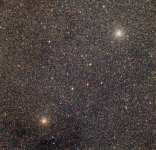Swimming Pool Physics
I've just discovered the Yarkovsky-O'Keefe-Radzievskii-Paddack (YORP) effect.
Aerospace engineer Stephen Paddack jumped into a swimming pool to do an experiment to figure out how asteroids spin!
YORP is a process that acts on asteroids to alter their spin. Visible light photons exert a force on the sunlit side of the asteroid and, when the heated side of the asteroid turns away from the Sun, infrared light photons are emitted which act like the exhaust of a rocket engine. Depending on the asteroid's tilt with respect to the Sun, this pair of forces either increases or decreases the asteroid's spin.
Paddack gathered up lots of rocks randomly and watched from underwater as an assistant released the stones. These experiments helped him to calculate the forces acting on an actual asteroid in space. 😎
Rotation of Asteroid Itokawa - YouTube
I've just discovered the Yarkovsky-O'Keefe-Radzievskii-Paddack (YORP) effect.
Aerospace engineer Stephen Paddack jumped into a swimming pool to do an experiment to figure out how asteroids spin!
YORP is a process that acts on asteroids to alter their spin. Visible light photons exert a force on the sunlit side of the asteroid and, when the heated side of the asteroid turns away from the Sun, infrared light photons are emitted which act like the exhaust of a rocket engine. Depending on the asteroid's tilt with respect to the Sun, this pair of forces either increases or decreases the asteroid's spin.
Paddack gathered up lots of rocks randomly and watched from underwater as an assistant released the stones. These experiments helped him to calculate the forces acting on an actual asteroid in space. 😎
Rotation of Asteroid Itokawa - YouTube
Check out this fantastic picture of the central parts of the MilkyWay, courtesy ESO.
Click in the ‘zoom tool’ link in the text under the pic for a zoomable version and try it. Staggering number of stars.
VISTA gigapixel mosaic of the central parts of the Milky Way | ESO United States
Click in the ‘zoom tool’ link in the text under the pic for a zoomable version and try it. Staggering number of stars.
VISTA gigapixel mosaic of the central parts of the Milky Way | ESO United States
That certainly gives a nice perspective.
We should immediately commence operation: getting off this rock!
We should immediately commence operation: getting off this rock!
Even more impressive is that in all likelihood, there’s not one planet in amongst the possibly millions orbiting those stars with intelligent life on them.
Bugs and creepy crawlies yes, but not advanced beings trying to nail fusion energy production and make the first tentative steps towards colonizing the galaxy.
Bugs and creepy crawlies yes, but not advanced beings trying to nail fusion energy production and make the first tentative steps towards colonizing the galaxy.
Do you know this paradox ?
The sky background should not be dark. There are so many stars around us in the universe, that at every point in the sky there is a star to bring light.
The sky background should not be dark. There are so many stars around us in the universe, that at every point in the sky there is a star to bring light.
Yes, I remember discussing it earlier in the thread.
Olbers' Paradox
The sky is dark because there hasn't been enough time for the light to reach us from the most distant stars.
Olbers' Paradox
The sky is dark because there hasn't been enough time for the light to reach us from the most distant stars.
Curiously enough, the first published solution to Olbers' Paradox is attributed to Edgar Allan Poe. In his essay Eureka, Poe says:
Olbers' Paradox | Astronomy 801: Planets, Stars, Galaxies, and the Universe"Were the succession of stars endless, then the background of the sky would present us a uniform luminosity, like that displayed by the Galaxy - since there could be absolutely no point, in all that background, at which would not exist a star. The only mode, therefore, in which, under such a state of affairs, we could comprehend the voids which our telescopes find in innumerable directions, would be by supposing the distance of the invisible background so immense that no ray from it has yet been able to reach us at all."
And he WENT! 😉GO Steve! 😉
He's now back communing with the stones.

Attachments
Wow. Again, very impressive.Curiously enough, the first published solution to Olbers' Paradox is attributed to Edgar Allan Poe. In his essay Eureka, Poe says:
Olbers' Paradox | Astronomy 801: Planets, Stars, Galaxies, and the Universe
Thirty days to launch, meaning sixty days (presuming all goes well and the creek don't rise) to first light. Or is that first heat?
https://twitter.com/NASA/status/1460762372176584706
https://twitter.com/NASA/status/1460762372176584706
Thanks, I had forgotten interesting details about it.Curiously enough, the first published solution to Olbers' Paradox is attributed to Edgar Allan Poe. In his essay Eureka, Poe says:
Olbers' Paradox | Astronomy 801: Planets, Stars, Galaxies, and the Universe
About stars so far that light has not reached us, yet.
Universe known expansion makes it worse. At some far away distance the speed of expansion is more than the speed of light, so this light will never, ever reach us.
This point has been pointed here, quite recently, telling about observable universe.
Indeed!Universe known expansion makes it worse. At some far away distance the speed of expansion is more than the speed of light, so this light will never, ever reach us.
Edgar Allan Poe provided the first plausible explanation of Olbers' Paradox, but was unaware of the expansion of the Universe.
He died 80 years before Edwin Hubble's discovery in 1929.
Like Harry Lauder, you certainly like Roamin' in the Gloamin'! 😀
Harry Lauder | Roamin' in the Gloamin' - YouTube
Here's the true explanation: Tidal locking - Wikipedia
I am not sure, but I think it is.
Yes, big difference between the assumed universe and the observable one. But, that is only constrained by Einsteinian physics. It does not take into account the concept of observation by quantum entanglement.
One theory is all of space-time already exists, but we are constrained in out view. I don't like that as it implies predestiny unless you subscribe to the all possible outcomes and that gets way too complicated. Nature likes the easy way out.
One theory is all of space-time already exists, but we are constrained in out view. I don't like that as it implies predestiny unless you subscribe to the all possible outcomes and that gets way too complicated. Nature likes the easy way out.
Anton the wonderful man had a vedio about expanding universe . He say black holes expand with expanding universe . Its pretty scary . That something exist thats stretching even blackholes. Can it be the universe is expanding to the atomic level . Stretching even the the atom . Also can gravitational waves effecting the background microwave radiation. And
- Status
- Not open for further replies.
- Home
- Member Areas
- The Lounge
- What is the Universe expanding into..

